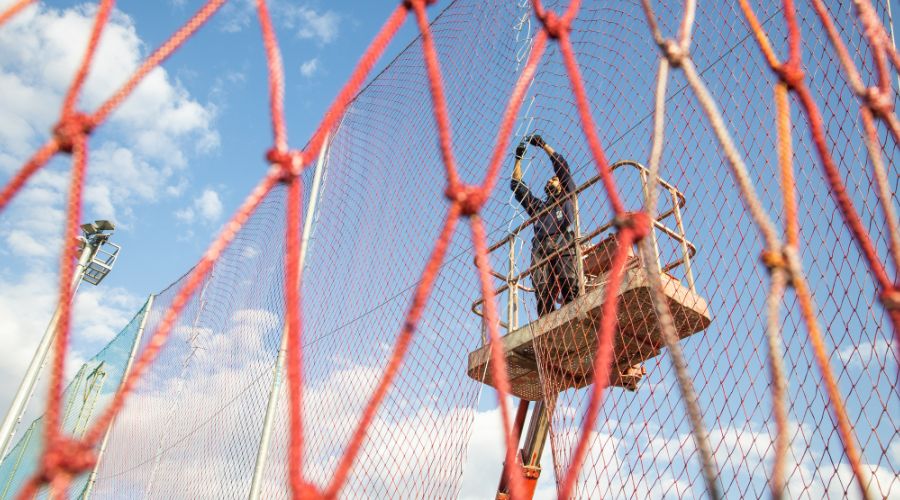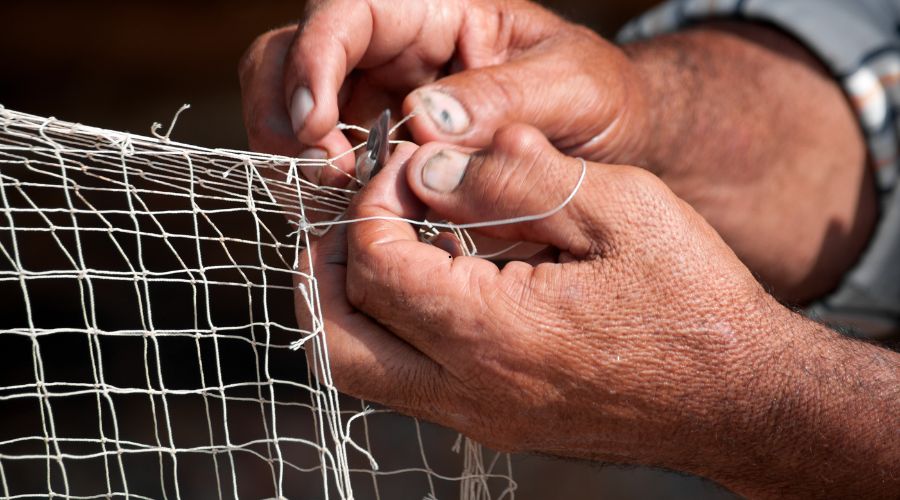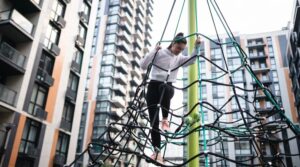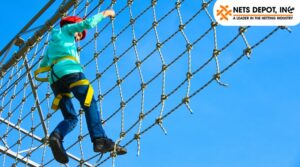If you’ve ever used a climbing cargo net, you know how important it is to ensure it remains in good condition. Whether it’s for a fitness obstacle course, playground, or training activity, a damaged climbing cargo net poses a safety risk and can lead to accidents. In this blog, we’ll walk you through the steps to properly inspect your climbing cargo net for wear and tear, highlight the importance of regular checks, and provide tips to maintain you’re net for optimal safety and longevity.
At Nets Depot Inc., we understand the critical role that climbing cargo nets play in ensuring safety and enjoyment during activities. That’s why we are committed to providing high-quality nets and detailed care instructions to keep your equipment in top shape.
Read also :- 7 Reasons Why Every Camper Needs a Climbing Cargo net
What is a Climbing Cargo Net?
A climbing cargo net is a versatile piece of equipment typically made from durable rope or webbing and designed for climbing, obstacle courses, or play areas. These nets allow users to scale vertical or horizontal surfaces, often used in fitness training, military exercises, or as part of recreational play structures.
Climbing cargo nets come in various designs, materials, and sizes, depending on their intended use. They can be suspended vertically for climbing or horizontally to act as bridges or walkways. Understanding the type of climbing cargo net you have is essential in performing a proper inspection.
Types of Climbing Cargo Nets
There are several types of climbing cargo nets, each designed for different purposes. At Nets Depot Inc., we offer a variety of nets to meet your specific needs. The most common types of climbing cargo nets include:
- Vertical Climbing Nets: These nets are typically fixed to a structure and used for climbing straight up and down.
- Horizontal Climbing Nets: Suspended between two points, horizontal nets allow users to crawl across them, often used in obstacle courses or as bridges.
- 3D Climbing Nets: These nets create cube or dome structures, frequently found in playgrounds.
- Knotted vs. Non-Knotted Nets: Some nets feature knots at each junction, while others may be fused or woven without knots.
- Fixed vs. Portable Nets: Fixed nets are securely attached to a structure, while portable nets can be moved as needed.
Read also :- Uses for Climbing Cargo Nets in Training and Play
Importance of Regular Inspections
Regular inspections of your climbing cargo net are crucial to ensure safety. Even a small amount of wear or tear can affect the net’s functionality and put users at risk. Inspecting your net before use and on a regular schedule is essential to catching damage early.
At Nets Depot Inc., we always recommend inspecting your climbing cargo net before every use, especially in high-traffic environments like obstacle courses or gyms. Frequent checks can help prevent accidents and extend the lifespan of your net.
What Tools Do You Need for Inspection?
Before starting your inspection, gather the necessary tools to perform a thorough check. You will need:
- Gloves: Protect your hands while handling the ropes, which can have sharp frays or be weathered.
- Flashlight: If you’re inspecting your net in low light, a flashlight will help you spot hidden issues.
- Inspection Checklist: A simple checklist can help ensure you don’t miss anything during the inspection.
- Camera: Use a camera to document any wear or damage, which can be helpful for repairs or warranty claims.
Key Areas to Inspect
When inspecting your climbing cargo net, there are several key areas to focus on. Let’s dive into the most critical parts of the net to check for signs of damage or wear.
Rope and Webbing Material
The material of your climbing cargo net is crucial for its strength and durability. Over time, UV rays, harsh weather, and frequent use can cause the fibers to weaken. Pay attention to:
- Fraying or unraveling ropes: Check for any broken strands or fraying at the edges.
- Brittle or stiff texture: If the material feels stiff or brittle, this may be a sign of UV degradation.
- Discoloration or fading: Extreme sun exposure can cause the net to fade, weakening the fibers.
Knots and Splices
If your net is knotted, inspect each knot for signs of loosening, fraying, or slippage. Over time, knots can become weak, and a compromised knot can lead to net failure. Similarly, check splices where ropes are joined to ensure they are securely tied or fused.
Anchoring Points
The anchoring points of your climbing cargo net are essential for ensuring it stays in place during use. Look for any rust, movement, or cracks around the anchors, hooks, or carabiners. Anchors should be solid, and the net should be taut without any sagging. If the anchor is unstable, it can cause the net to fail when in use.
Net Structure and Geometry
Inspect the net structure for signs of stretching or sagging. The individual squares of the net should remain uniform. Any areas where the net is overly stretched or distorted could compromise its performance. Ensure the net is still in proper alignment, and there are no gaps where users could slip through.
To choose the best climbing cargo net, ensure that it is made of high-quality materials, properly designed for its intended use, and has robust safety features to minimize any risks.
Environmental Factors
The elements can have a significant impact on the longevity of your climbing cargo net. Be sure to consider the following environmental factors when inspecting your net:
- UV Damage: Exposure to sunlight can degrade the fibers of the net, making them brittle and more prone to breaking.
- Moisture and Mildew: Wet conditions, especially in natural fiber nets, can lead to mold or mildew buildup.
- Cold Weather: Extreme cold can make some materials, like nylon, more rigid and prone to cracking.
- Rodent or Insect Damage: Animals may chew on or nest within the net, weakening its structure.
When to Replace or Repair Your Climbing Cargo Net
After inspecting your climbing net, you may face the decision of whether to repair or replace it. Here are some general guidelines:
- Repairs: Minor fraying, small cuts, or loose knots can often be repaired with simple fixes like retying or reinforcing the net with additional material.
- Replacement: If you notice deep tears, compromised anchor points, or significant degradation of the material, it may be time to replace the net altogether.
For further guidance on repairs or replacement, contact us at Nets Depot Inc., where our experts can assist you in maintaining or upgrading your equipment.
To view our full range of climbing cargo nets, visit our Google My Business page.
Proper Climbing Techniques
Properly maintaining and inspecting your climbing cargo net is just one part of ensuring a safe and effective experience. Once you’ve ensured your net is in optimal condition, the next step is to practice the correct techniques. Users should practice their climbing methods regularly to build strength and confidence. Proper body mechanics and techniques can help you scale the net with greater ease and minimize strain. Consider offering climbing tips or organizing training sessions to help people learn how to navigate the net safely. When users are properly trained, they can minimize risks associated with improper use of the equipment. This will allow them to master climbing a cargo net effectively, ensuring both safety and efficiency during use. Proper technique ensures that the net remains in excellent condition and prevents unnecessary wear and tear.
Conclusion
In conclusion, inspecting your climbing cargo net regularly is essential to ensuring safety and preventing accidents. By checking key areas such as rope material, knots, anchors, and overall structure, you can catch damage early and extend the life of your net.
At Nets Depot Inc., we are committed to providing high-quality nets and expert guidance on their maintenance. Remember, a well-maintained climbing net not only ensures a safe experience but also saves you money in the long run.
If you need assistance with inspecting, repairing, or purchasing a new climbing cargo net, don’t hesitate to contact us. Our team is here to help you keep your climbing nets in top condition.
Frequently Asked Questions (FAQ)
Q1. How often should I inspect my climbing cargo net?
It’s recommended to inspect your climbing cargo net before every use, especially in high-traffic areas or environments like obstacle courses or playgrounds. Additionally, regular inspections should be done seasonally or annually, depending on usage.
Q2. Can I repair a climbing cargo net myself?
Yes, minor issues like frayed ropes, small cuts, or loose knots can often be repaired by retying the knots, reinforcing weak spots with new material, or using proper repair techniques. However, if the damage is extensive (like large tears or damaged anchor points), it’s best to replace the net.
Q3. How can I protect my climbing cargo net from UV damage?
To protect your net from UV damage, avoid prolonged exposure to direct sunlight. When the net is not in use, consider storing it in a shaded area or indoors. Regularly cleaning and maintaining your net will also help prolong its lifespan.
Q4. What material is best for a climbing cargo net?
Nylon and polypropylene are some of the best materials for climbing nets because they are durable, resistant to wear, and can handle a lot of weight. If your net is exposed to the elements, ensure it is UV-resistant to prevent weakening.
Q5. How can I prevent mildew from forming on my climbing cargo net?
To prevent mildew, ensure your climbing cargo net is dry after use, especially in humid or wet conditions. If the net becomes wet, allow it to dry completely before storing it. For natural fiber nets, consider using mildew-resistant treatments.






